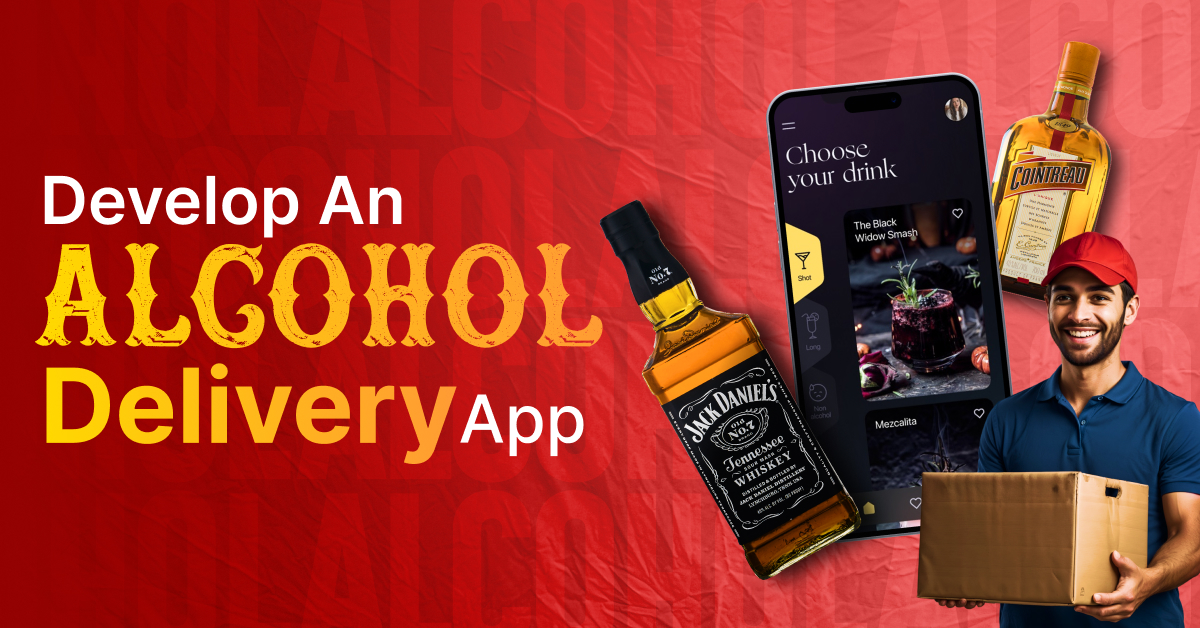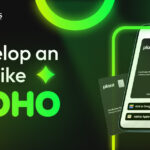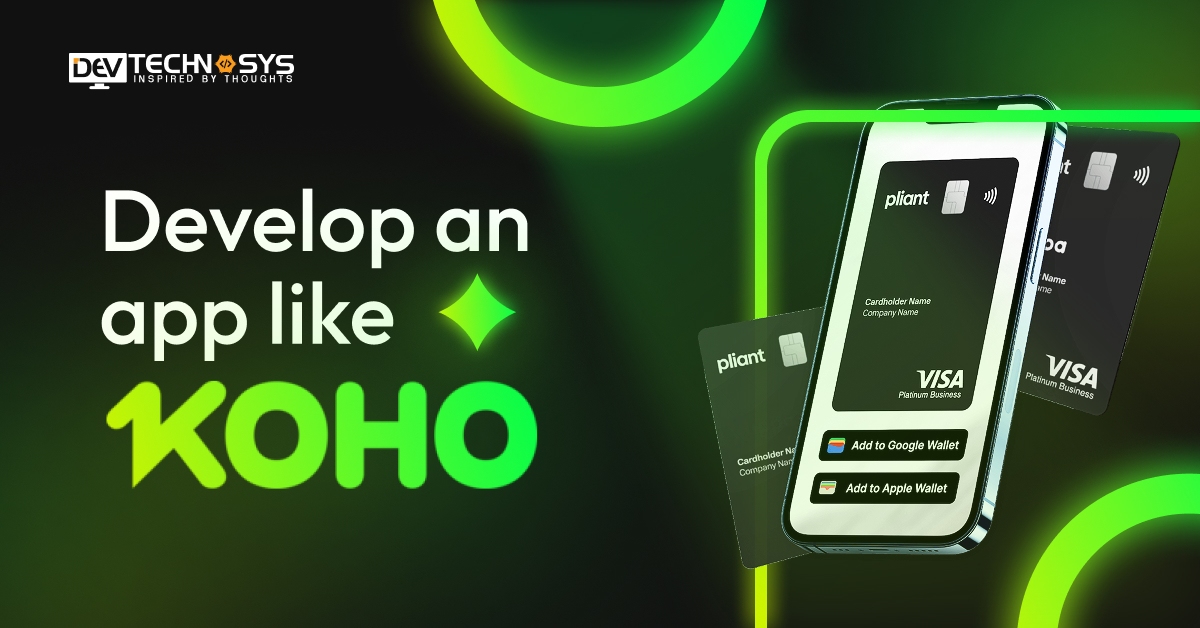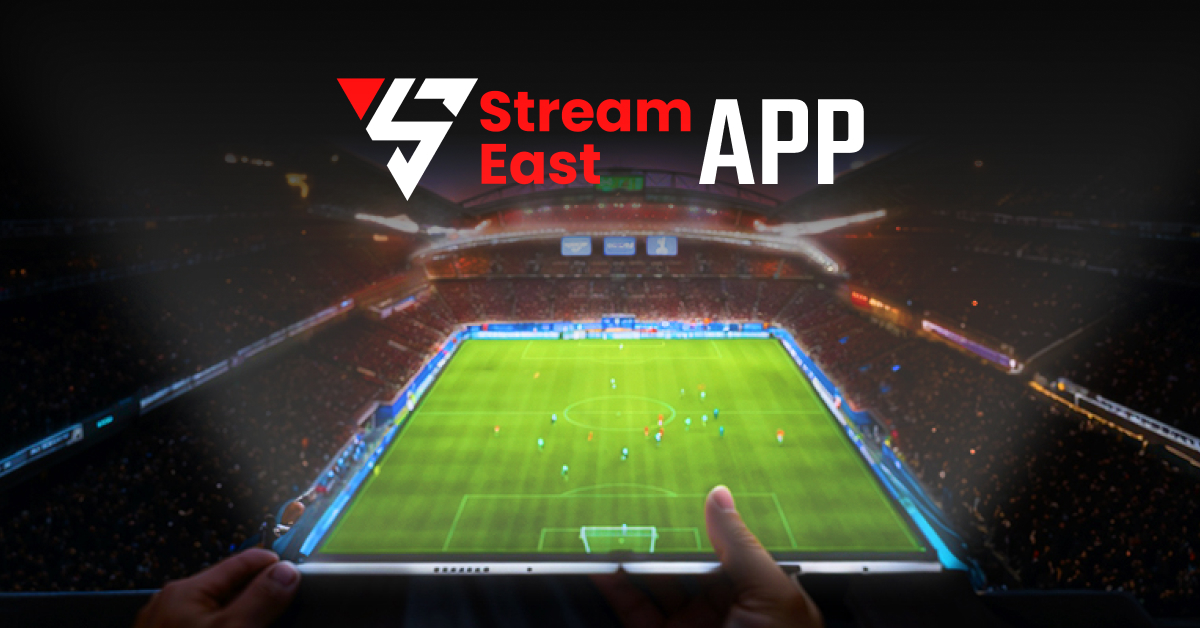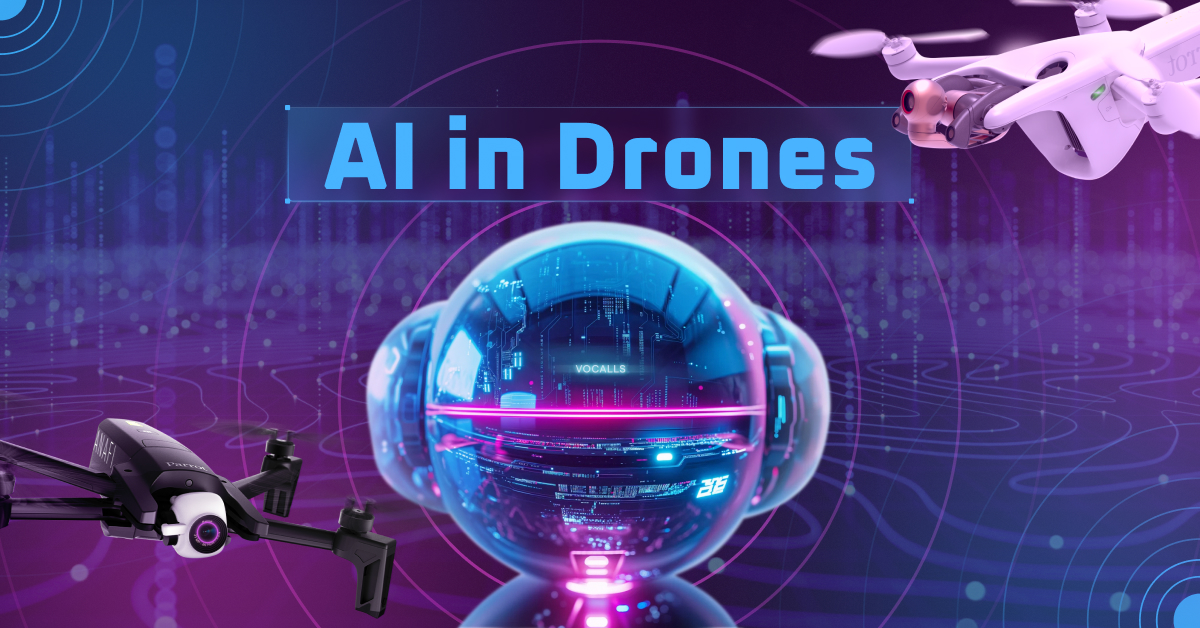Peoples has to stand in a long line for a bottle of alcohol till their number comes. As we can see, all items from food to groceries are delivered to your home. So, can’t alcohol be delivered? Why not? There are many popular delivery apps that deliver alcohol, which have already gained huge popularity in the digital market.
Through in-depth research, the Alcohol Delivery Service Market, valued at USD 10.33 billion in 2023, is projected to experience significant growth, reaching approximately USD 23.3 billion by 2031.
The above data shows that investing in the alcohol delivery app development is a massive opportunity for businesses to increase their overall growth.
Get ready to explore how to develop an alcohol delivery app and what features and functions should be integrated.
Let’s begin!
What is the Alcohol Delivery App?
An on-demand alcohol delivery app is a mobile application that enables customers to browse, purchase, and receive alcoholic beverages directly to their doorstep. It integrates product catalogs, secure payment choices, and real-time delivery monitoring while maintaining legal compliance, such as age verification.
A liquor delivery app like Drizly is designed for convenience, connecting clients with local businesses or wholesalers to ease the alcohol purchase process through digital technology and on-demand delivery.
- Age Verification
- Product Catalog
- Real-Time Order Tracking
- Geolocation Services
Market Analysis of Global Alcohol Delivery Applications
- The market for alcohol delivery services, which was estimated to be worth USD 10.33 billion in 2023, is expected to increase significantly, reaching almost USD 23.3 billion by 2031.
- According to the global market, the alcohol delivery app USA market is expected to increase with a compound annual growth rate of 9.45% from 2024 to 2031.
- The necessity of alcohol delivery services Growing smartphone use, the expansion of e-commerce, shifting consumer behavior, and regulatory changes are the main factors driving the market.
- Drizly, Minibar Delivery, Winc, Tavour, We Drink Bubbles, Afterhours, Booze Run, Saucey, and Instacart are the main competitors.
- Type, Platform, End-User, and Geography are the factors used to segment the global market for alcohol delivery services.
Top 10 Alcohol Delivery Applications
The best liquor delivery apps offer fast, reliable service with wide selections, secure payments, and age verification, revolutionizing how consumers conveniently purchase and receive alcoholic beverages today.

Applications |
Download Users |
Stores Ratings |
Apps Launched On |
Platform Accessibility |
| Drizly | 10M+ | 4.8 | 2012 | Android/iOS |
| Minibar Delivery | 1M+ | 4.7 | 2014 | Android/iOS |
| Gopuff | 10M+ | 4.6 | 2013 | Android/iOS |
| Postmates | 10M+ | 4.7 | 2011 | Android/iOS |
| Zé Delivery | 10M+ | 4.7 | 2015 | Android/iOS |
| ReserveBar | 100K+ | 4.5 | 2013 | Android/iOS |
| CraftShack | 100K+ | 4.6 | 2013 | Android/iOS |
| Winc | 100K+ | 4.7 | 2011 | Android/iOS |
| Firstleaf | 100K+ | 4.6 | 2016 | Android/iOS |
| Living Liquidz | 10K+ | 4.5 | 2015 | Android/iOS |
Why Today’s Entrepreneurs Invest in Alcohol Delivery App Development?
The alcohol delivery market is rapidly expanding, presenting lucrative opportunities for entrepreneurs. Several compelling reasons drive this growing investment trend:
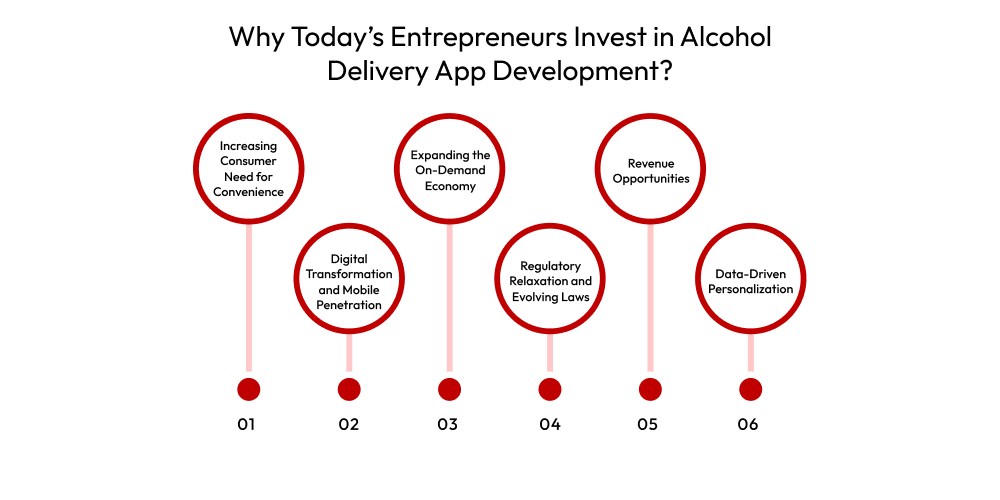
- Increasing Consumer Need for Convenience
- Digital Transformation and Mobile Penetration
- Expanding the On-Demand Economy
- Regulatory Relaxation and Evolving Laws
- Revenue Opportunities
- Data-Driven Personalization
1. Increasing Consumer Need for Convenience
Modern customers value convenience and time-saving solutions. Liquor delivery apps perfectly meet this need by allowing users to explore and buy beverages from the convenience of their own homes, eliminating journeys to stores or bars. This convenience factor considerably improves user adoption and retention.
2. Digital Transformation and Mobile Penetration
With smartphone usage on the rise worldwide, alcohol delivery on-demand app development solutions have emerged as primary channels for purchasing and providing services. Entrepreneurs know that creating a liquor delivery app capitalizes on the mobile-first trend, allowing them to quickly access a larger, tech-savvy clientele.
3. Expanding the On-Demand Economy
The popularity of on-demand businesses such as food and grocery delivery has opened the door for a liquor delivery app solution. Entrepreneurs aim to capitalize on this established customer behavior by providing speedy, dependable alcohol delivery services, therefore entering a sector with proven demand.
4. Regulatory Relaxation and Evolving Laws
Many jurisdictions have reduced alcohol sales and delivery rules, particularly after the epidemic, allowing for easier market entrance. Entrepreneurs view this as a window of opportunity to develop compliant, scalable apps without facing significant regulatory restrictions.
5. Revenue Opportunities
Alcohol sales frequently include premium pricing and customer loyalty schemes. If entrepreneurs create a mobile app like an alcohol delivery service, it may generate significant revenue through delivery fees, subscription models, and exclusive deals, ensuring a steady cash flow and company viability.
6. Data-Driven Personalization
The Uber alcohol delivery apps let entrepreneurs capture important consumer data for tailored marketing, targeted promotions, and better customer experiences. This data-driven strategy boosts engagement while maximizing lifetime customer value.
Interested in a chatbot demo, pricing, or more info? Fill out the form our expert will contact you shortly.
-
Chatbot Demo
-
Cost to Develop an app
-
Industry Report
-
Case Study
How AI Can Improve the Operations of Alcohol Delivery Apps?
- AI-powered demand forecasting helps optimize inventory, reducing stockouts and overstock, ensuring popular alcohol products are always available for timely delivery.
- Personalized recommendations based on user preferences and purchase history enhance customer satisfaction and increase average order value through targeted product suggestions.
- Intelligent route optimization algorithms minimize delivery times and fuel consumption, enabling faster service and lowering expenses for delivery drivers and companies.
- Sentiment analysis of customer reviews and feedback helps identify service weaknesses and improve app features, marketing strategies, and product offerings.
- AI-driven fraud detection protects against fraudulent transactions and fake accounts, enhancing payment security and maintaining trust within the alcohol delivery ecosystem.
7 Basic Steps to Develop An Alcohol Delivery App
To develop an alcohol delivery app, it involves strategic planning, legal compliance, intuitive design, and robust technology. From research and feature definition to testing and launch, each step ensures a seamless, secure, and user-friendly experience that meets evolving customer expectations and regulatory standards.
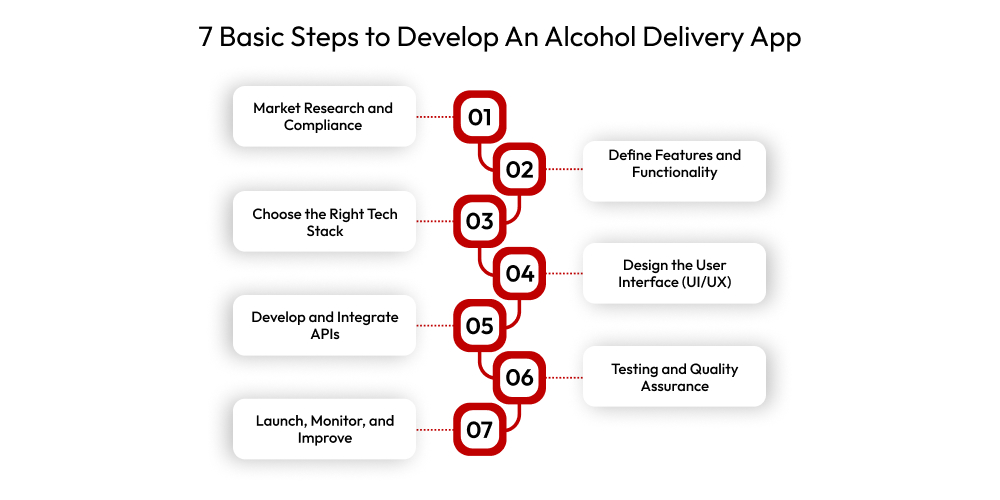
- Market Research and Compliance
- Define Features and Functionality
- Choose the Right Tech Stack
- Design the User Interface (UI/UX)
- Develop and Integrate APIs
- Testing and Quality Assurance
- Launch, Monitor, and Improve
1. Market Research and Compliance
In the first stage to build a liquor delivery app, hire developers from a mobile app development firm to start with in-depth market research to understand user needs, trends, and competitors.
Study alcohol regulations and legal requirements in targeted regions to ensure compliance with licensing, age verification, and delivery restrictions. This foundational step ensures your app operates lawfully and aligns with consumer expectations.
| Who is our target audience for alcohol delivery services? |
| What are the current trends in alcohol e-commerce? |
| Which regions have the highest demand for alcohol delivery? |
2. Define Features and Functionality
Outline core features: user registration, product catalog, age verification, geolocation, real-time tracking, and payment integration. Consider adding advanced options like personalized recommendations, loyalty programs, and in-app customer support. A clear feature roadmap sets the foundation for design, development, and a competitive user experience.
| What core features should the app include at launch? |
| How will users browse and search for products? |
| What payment methods should be supported? |
3. Choose the Right Tech Stack
You can consult with an food ordering app development company to select a suitable technology stack for backend, frontend, and database. Common choices include React Native or Flutter for cross-platform apps, Node.js or Django for backend, and Firebase or MongoDB for data.
Ensure the tech stack supports scalability, performance, and seamless integration with APIs and payment gateways.
| Which frameworks best support real-time features? |
| Which database will handle high traffic efficiently? |
| Will the stack support future updates and new features? |
4. Design the User Interface (UI/UX)
Create wireframes and prototypes focusing on simplicity, aesthetics, and intuitive navigation. Prioritize user-friendly interfaces for both customers and delivery personnel.
Ensure mobile responsiveness and accessibility standards are met. A well-crafted design directly impacts user engagement, satisfaction, and overall app retention rates in a competitive market.
| How can we make the interface simple and intuitive? |
| What visual style best suits our brand and audience? |
| Is the design optimized for both iOS and Android devices? |
5. Develop and Integrate APIs
In the fifth liquor delivery app development stage, assemble a skilled team from iOS app development company to begin coding based on your chosen stack, integrating APIs for payments, geolocation, ID verification, and push notifications.
Ensure secure data handling and encryption protocols. Modular development allows testing of individual components, making future maintenance easier and ensuring reliable performance under varying user and transaction loads.
| Which core features require API integration? |
| What third-party APIs do we need (e.g., payments, maps)? |
| What API will verify customer age and identity? |
6. Testing and Quality Assurance
Conduct rigorous testing, including unit, integration, UI/UX, and stress tests across multiple devices. Identify and fix bugs, improve performance, and ensure a seamless user experience. Simulate real-world usage scenarios.
Quality assurance ensures reliability, reduces user churn, and supports a smooth app launch with minimal post-release issues.
| Have all core features been tested thoroughly? |
| Are there any UI/UX bugs affecting user flow? |
| Have all third-party APIs been tested for reliability? |
7. Launch, Monitor, and Improve
In the last alcohol delivery business app development process, deploy the app on iOS and Android platforms, followed by active performance monitoring and feedback collection. Analyze user behavior using analytics tools and address issues promptly.
Regularly update features and security patches. Continuous improvement based on data and feedback sustains growth and enhances user satisfaction over time.
| Is the app store submission process complete and approved? |
| Are analytics tools properly integrated for tracking user behavior? |
| How will we monitor app crashes and bugs post-launch? |
10 Normal and Advanced Features of Alcohol Delivery Applications
These features collectively create a seamless, secure, and enjoyable alcohol delivery experience that meets both customer needs and regulatory requirements.
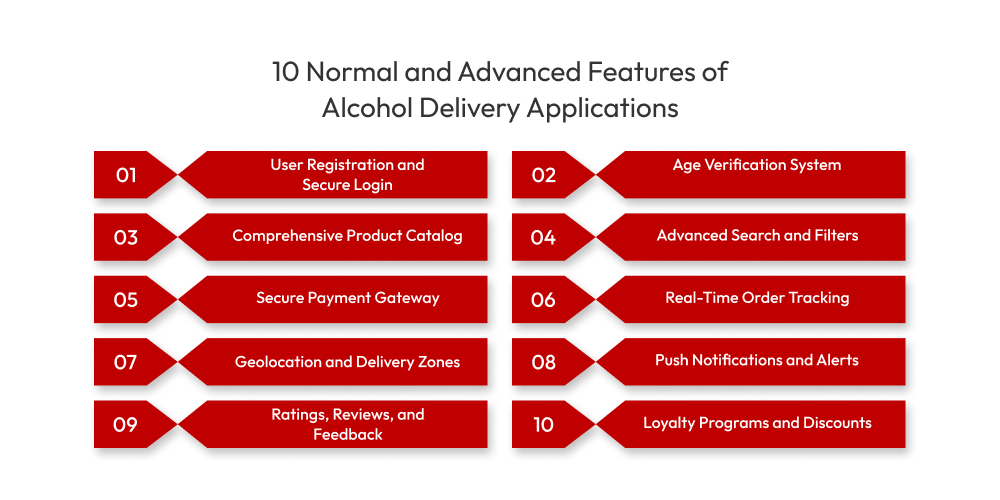
1. User Registration and Secure Login
Users may instantly establish accounts using their email addresses, phone numbers, or social network profiles. Secure authentication secures personal information while streamlining future orders.
2. Age Verification System
A required feature for ensuring compliance with legal drinking age legislation by validating user identification via document uploads or third-party verification services.
3. Comprehensive Product Catalog
Offers thorough descriptions, photographs, pricing, and user reviews for a variety of alcoholic drinks, such as beers, wines, spirits, and cocktails.
4. Advanced Search and Filters
Users may rapidly locate desired items using criteria such as brand, kind, price range, popularity, or user ratings, which improves shopping efficiency.
5. Secure Payment Gateway
Multiple payment options are supported, including credit/debit cards, digital wallets, and UPI, guaranteeing that transactions within the app are fast, easy, and safe.
6. Real-Time Order Tracking
If you build a delivery service app, it provides clients with real-time tracking of their orders from preparation to delivery, increasing transparency and minimizing customer worry.
7. Geolocation and Delivery Zones
Automatically recognizes the user’s location and displays available items and delivery choices, while effectively managing service zones.
8. Push Notifications and Alerts
Notifies users about order progress, promotions, new arrivals, and unique discounts to encourage repeat purchases and engagement.
9. Ratings, Reviews, and Feedback
Customers may review items and delivery experiences, which fosters confidence and helps other users make educated selections.
10. Loyalty Programs and Discounts
Encourages user retention by providing awards, points, and targeted offers to repeat consumers, resulting in increased revenue and client loyalty.
What is the Cost to Develop an Alcohol Delivery App?
The cost to build an alcohol delivery app varies widely based on features, complexity, and development region. Basic apps with essential features like user registration, product catalog, age verification, and payment integration typically start around $8,000 to $15,000.
More advanced apps with real-time tracking, AI recommendations, and multi-vendor support can cost upwards of $25,000 or more. Additional expenses include UI/UX design, backend infrastructure, API integrations, and ongoing maintenance.
Legal compliance and security measures may also add to development costs, making thorough planning essential.
Cost to Develop An Alcohol Delivery App
Alcohol Delivery App Development |
Estimated Cost |
Time Frame |
| Basic App Development | $8000 – $12000 | 2 to 4 Months |
| Mid-Premium App Development | $14000 – $19000 | 5 to 8 Months |
| High-Premium App Development | $25000+ | 9+ Months |
5 Crucial Factors That Affect the Alcohol Delivery App Development Cost
Crucial factors affecting alcohol delivery app development cost include app complexity, feature set, platform choice (iOS, Android, or both), design quality, backend infrastructure, third-party API integrations, development team location, legal compliance requirements, security measures, and ongoing maintenance. Each element significantly impacts the overall investment needed for successful app creation.
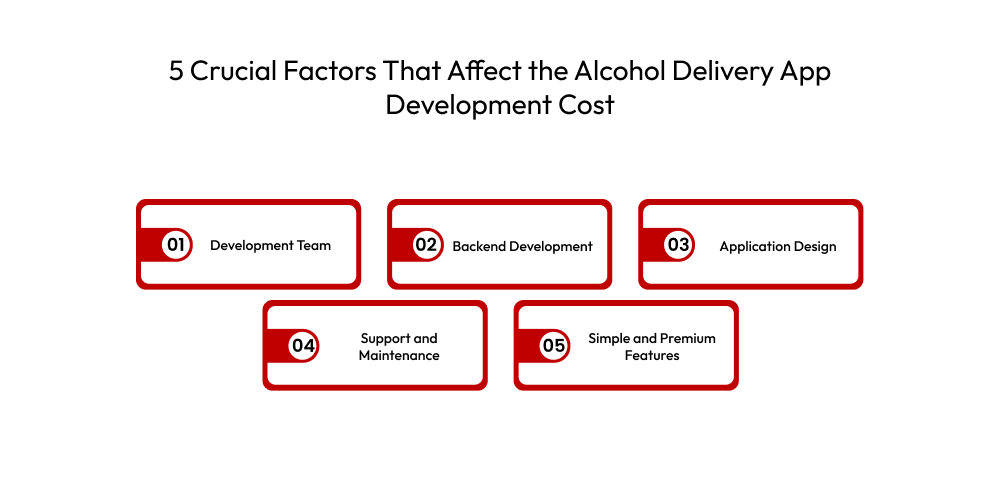
1. Development Team
The cost is greatly dependent on the team’s experience, size, and location. Experienced developers in high-cost locales charge more, whereas offshore teams provide reduced prices. The mix of frontend, backend, and QA specialists affects timeliness and quality, which has a direct impact on the cost to build a 10-minute delivery app.
Developers Experience level |
United States |
United Kingdom |
Southeast Asia |
Eastern Europe |
| Junior-level | $15 – $25 | £14 – £24 | $12 – $22 | $10 – $20 |
| Mid-level | $30 – $50 | £27 – £44 | $25 – $35 | $25 – $33 |
| Senior-level | $60 – $80 | £50 – £65 | $40 – $55 | $40 – $50 |
2. Backend Development
Backend operations include data management, user authentication, APIs, and server logic. Complex backend systems that enable real-time tracking, inventories, and payments raise expenses.
Scalable, secure infrastructure necessitates investment in architecture and cloud services, which directly affect development time and costs for a strong, dependable app for liquor delivery.
Backend Complexity |
Estimated Cost (USD) |
Estimated Time |
| Basic Backend | $5,000 – $10,000 | 3 – 6 weeks |
| Advanced Backend | $10,000 – $18,000 | 6 – 10 weeks |
3. Application Design
Design quality influences user engagement and retention. Custom, intuitive UI/UX demands more effort and competent designers, which raises the cost to build an app like Gopuff. Simple templates cut costs but may restrict brand individuality. The design must also be responsive and accessible across devices, which increases development time and influences the final cost.
Design Quality |
Cost Estimation |
| Basic Design | $8,000 – $12,000 |
| Complex Design | $15,000 – $22,000 |
4. Support and Maintenance
Post-launch support includes bug fixes, updates, security patches, and performance monitoring. Continuous maintenance is critical for app stability and user pleasure, and it often costs 15-20% of the initial booze delivery app development budget each year. Ignoring this can lead to app failures, user loss, and higher long-term costs.
Service Level |
Description |
Estimated Annual Cost (USD) |
Estimated Time |
| Basic Support | Bug fixes, minor updates | $3,000 – $6,000 | Ongoing |
| Comprehensive Support | Frequent updates, performance optimization | $6,000 – $9,000 | Ongoing |
5. Simple and Premium Features
Basic services such as user registration and product browsing are more affordable. Advanced features such as AI suggestions, dynamic pricing, and multi-vendor support need more resources and lead to longer development times. The amount and complexity of features chosen have a major impact on the overall cost to develop an app like 7Now.
Basic Features |
Estimated Cost |
Advanced Features |
Estimated Cost |
| Basic Product Catalog | $6,000 – $9,000 | Advanced AI-Powered Product Recommendations | $4,000 – $7,000 |
| Search and Basic Filters | $4,000 – $7,000 | Real-Time GPS Delivery Tracking | $3,000 – $5,000 |
| User Registration and Login | $8,000 – $12,000 | Multi-Vendor Marketplace Support | $10,000 – $14,000 |
| Add to Cart and Checkout | $7,000 – $11,000 | Dynamic Pricing and Discount Management
|
$7,000 – $10,000 |
| Basic Age Verification | $10,000 – $12,000 | Augmented Reality (AR) for Product Visualization | $10,000 – $15,000 |
How to Make Money From Alcohol Delivery Applications?
The app for alcohol delivery can create a diverse revenue model by combining various monetization techniques, ensuring profitability while providing value to both partners and consumers. Long-term success and income maximization can be achieved by understanding your target market and adjusting offers and prices accordingly.
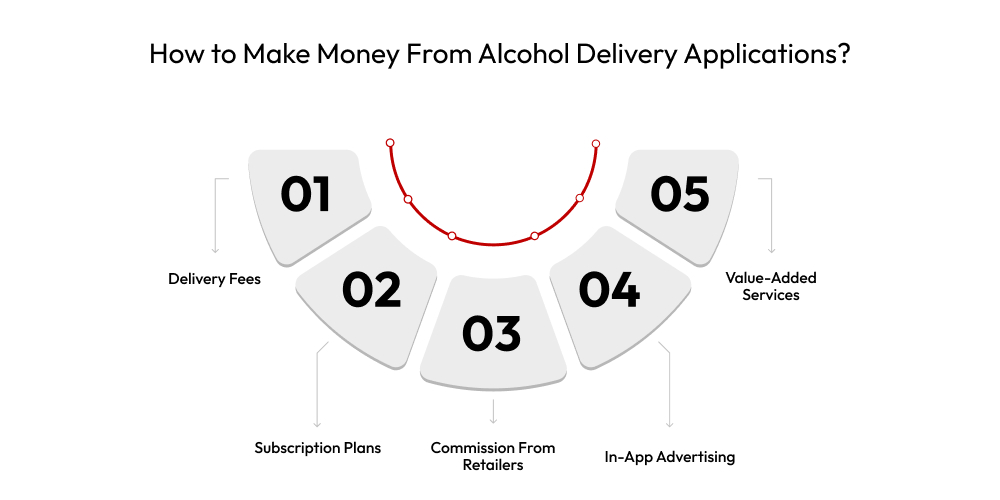
- Delivery Fees
- Subscription Plans
- Commission from Vendors
- In-App Advertising
- Value-Added Services
1. Delivery Fees
One of the most straightforward revenue streams is charging clients a delivery fee for every order. This price may be set or variable, depending on distance, order quantity, or delivery speed. Charging for rapid or express delivery alternatives generates additional revenue while paying operating costs.
2. Subscription Plans
The online alcohol delivery app solution offers premium subscription services with perks such as free delivery, special discounts, or early access to new items, which might entice loyal consumers to pay on a regular basis. According to the mobile app development agency, monthly or yearly membership fees increase recurrent income and client retention.
3. Commission from Vendors
Top alcohol delivery apps frequently collaborate with local retailers, breweries, or distributors, receiving a commission on each transaction completed through the site.
This fee normally varies from 10% to 30% per transaction, depending on the arrangement, resulting in a consistent and scalable revenue stream as order quantities rise.
4. In-App Advertising
Apps can make money by displaying sponsored listings, banner adverts, and promoted items from brands and sellers. Collaborations with an alcohol delivery app development company for unique releases or promotions increase awareness while monetizing app real estate without affecting the user experience.
5. Value-Added Services
If entrepreneurs invest in grocery app development services, they offer additional services, such as curated gift packs, drink recipe manuals, event-based promotions, or tailored suggestions, which raise the average purchase value.
Upselling premium or exclusive items, as well as providing add-ons such as mixers or glasses, increases revenue per customer and boosts user engagement.
Conclusion
Creating booze delivery apps needs meticulous planning, design, and legal compliance. It is critical to select the appropriate features, such as age verification and secure payments, to create a safe and enjoyable user experience.
Working with a reputable mobile app development company will help you transform your idea into a working app that includes skilled technical assistance. In today’s fast-paced world, you may design a successful software that meets the demands of users while adhering to all regulations.
Frequently Asked Questions
Q1. How Much Does it Cost to Develop an Alcohol Delivery App?
The cost to build an alcohol delivery app typically ranges from $8,000 to over $25,000, depending on features, design complexity, platform choice, and development team location, plus ongoing maintenance and legal compliance expenses.
Q2. How Much Time Does It Take To Create an Alcohol Delivery App?
To create an alcohol delivery app, the development process typically takes between 3 and 6 months, depending on the complexity, feature set, design, backend development, testing, and team efficiency. Additional time is required for legal approvals and post-launch improvements.
Q3. Which Technologies Are Used to Make an Alcohol Delivery App?
There are various technologies used to make an alcohol delivery app, such as React Native, Java, Kotlin, C++, Python, and many more. These technologies help businesses develop a successful alcohol delivery driver app.
Q4. How Do I Ensure Legal Compliance with Alcohol Delivery?
Obtain the necessary permits, enforce stringent age verification, adhere to delivery time and location limits, and obey local and federal liquor regulations to guarantee legal compliance with alcohol delivery. For assistance with the regulatory requirements unique to each operating location, consult legal professionals.
Q5. Can I Include Multiple Vendors in One App?
Yes, you may incorporate numerous suppliers in the same app by using a multi-vendor marketplace architecture. This enables several storefronts to sell items, manage orders, and accept payments via a single admin interface that provides real-time coordination.
Q6. Which Delivery Apps Deliver Alcohol?
Popular delivery apps that deliver alcohol include Drizly, DoorDash, Uber Eats, Postmates, and Instacart. These platforms partner with local stores to provide convenient alcohol delivery, often featuring age verification and real-time order tracking.
